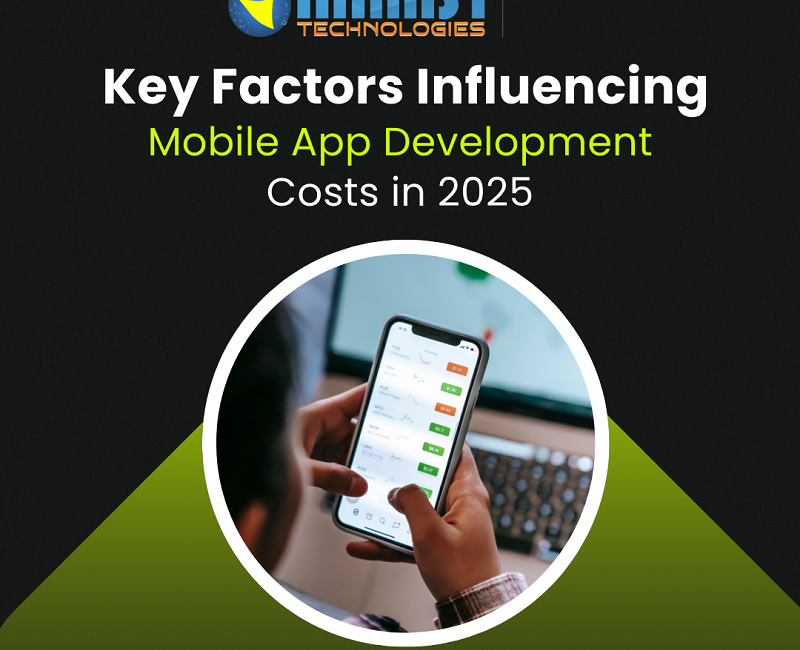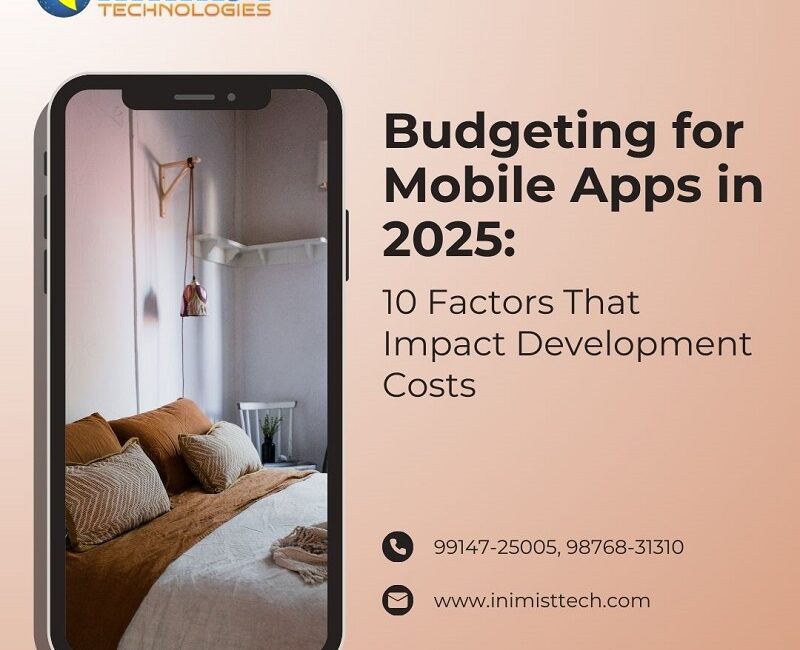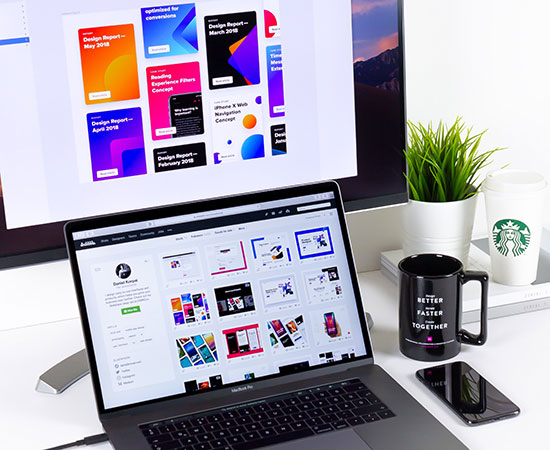Always start by defining your goal, target audience, and core features, and then consult with a trusted developer or agency to get a custom quote.

Inimist Tech | June 22, 2024
Key Factors Influencing Mobile App Development Costs in 2025
Developing a mobile app in 2025 can be a great way to grow your business, offer services, or just bring a new idea to life. But one of the first questions that comes up is: “How much will it cost?”
There’s no one-size-fits-all answer because the cost of building an app depends on many things. Let’s break down the key factors that influence mobile app development costs in 2025.

1. Type of App You Want to Build
Just like cars come in different models—basic hatchbacks vs. luxury SUVs—apps also come in different types. Here’s how this affects cost:
-
Simple Apps (like a calculator or to-do list): These are easier and faster to make, so they cost less.
-
Moderate Apps (like a fitness tracker with login and progress tracking): These need more work and features, so they cost more.
-
Complex Apps (like Uber, Instagram, or banking apps): These are expensive because they need user accounts, real-time updates, payments, maps, and more.
Cost Impact:
The more complex your app is, the more time and expertise it takes, which increases the cost.
2. Platform: Android, iOS, or Both
There are mainly two platforms for mobile apps: Android and iOS.
-
Android: Apps run on Samsung, OnePlus, and most other phones.
-
iOS: Apps run on Apple devices like iPhones and iPads.
-
Cross-Platform: One app that works on both, using tools like Flutter or React Native.
Cost Impact:
-
Building for one platform is cheaper.
-
Building for both platforms separately nearly doubles the cost.
-
Cross-platform apps save time and money, but may have limitations in very complex apps.
3. Design and User Experience (UI/UX)
Think of the design as how your app looks and feels when people use it.
-
A basic design with simple buttons is cheaper.
-
A modern, smooth, and interactive design costs more because it requires extra time and skills.
Also, better design = more users and happier customers. So while good design costs more, it often pays off.
Cost Impact:
Clean and interactive designs are worth investing in, but they can increase your budget.
4. Features and Functionalities
This is one of the biggest cost drivers.
Some common features and their impact:
-
User login – Basic, but requires secure coding.
-
Payment gateway – Adds complexity and cost.
-
Chat/messaging – Needs backend services.
-
GPS/Maps – Needs integration with Google Maps or Apple Maps.
-
Push notifications – Increase user engagement, but add coding effort.
Cost Impact:
More features = more development time = higher cost.
5. Backend and Server Requirements
The backend is like the engine of your app—it runs in the background and handles things like:
-
Saving user data
-
Processing requests (like food orders or chat messages)
-
Connecting the app to a database
Apps like Instagram or Uber need strong, secure, and fast backends.
Cost Impact:
If your app needs a backend, costs go up due to server setup, database management, and security.
6. App Maintenance and Updates
Building the app is not the end. You’ll need to:
-
Fix bugs
-
Add new features
-
Update it when new phones or operating systems come out
Think of it like a car—you need to service it regularly to keep it running smoothly.
Cost Impact:
Annual maintenance can be 15–25% of the original app development cost.
7. Who Builds Your App: Freelancer vs. Agency vs. In-House Team
Who you choose to build your app affects both cost and quality:
-
Freelancers: Usually cheaper but might lack reliability or a full skill set.
-
App Development Agencies: More expensive, but offer a complete team—designers, developers, testers, project managers.
-
In-house Team: Long-term option for companies, but involves salaries, office costs, and hiring.
Cost Impact:
Freelancers are budget-friendly, but agencies offer more professional results (at a higher cost).
8. Geographic Location of the Development Team
Where your development team is located also plays a big role in cost.
Here’s a rough idea of hourly rates:
-
USA/Canada: $100–$200/hour
-
Western Europe: $80–$150/hour
-
Eastern Europe: $40–$80/hour
-
India & Southeast Asia: $15–$50/hour
Cost Impact:
Outsourcing to countries with lower rates can save a lot—just ensure quality control.
9. Use of AI, AR/VR, or Advanced Tech
In 2025, many apps are using new technologies like:
-
AI (Artificial Intelligence) – For smart chatbots or recommendations.
-
AR/VR (Augmented & Virtual Reality) – For games, interior design apps, etc.
-
Blockchain – For secure transactions or identity verification.
These technologies are exciting but not cheap to implement.
Cost Impact:
Advanced tech can increase your budget by 30–100% depending on complexity.
10. Security and Compliance
If your app handles payments, health data, or personal information, it needs to follow rules like:
-
GDPR (for Europe)
-
HIPAA (for US healthcare apps)
-
PCI-DSS (for payments)
This requires encryption, data safety protocols, and legal compliance—all of which take time and specialized skills.
Cost Impact:
More regulation = more cost for legal, technical, and security expertise.
11. Integration with Other Services
Apps often need to work with:
-
Google or Apple login
-
Social media sharing
-
Payment services like Stripe or Razorpay
-
Third-party APIs like weather or translation
Cost Impact:
Each integration takes time to set up and test, increasing the cost.
12. Testing and Quality Assurance (QA)
Before launching, your app must be tested on different devices to catch bugs and issues. Testing includes:
-
Manual testing
-
Automated testing
-
Security testing
-
Usability testing
Cost Impact:
Quality assurance is essential, but it adds to the project budget. Cutting corners here can lead to a buggy app and poor reviews.
Final Thoughts
In 2025, building a mobile app can cost anywhere from $5,000 to $500,000 or more, depending on all the factors above. Here’s a quick summary:
| Factor | Impact on Cost |
|---|---|
| App Type | Basic = Low, Complex = High |
| Platform | Single = Cheaper, Both = Costlier |
| Features | More = Higher cost |
| Design | Better design = More cost |
| Backend | Required = Adds cost |
| Maintenance | Ongoing yearly expense |
| Developer Type | Freelancers < Agencies < In-house |
| Location | Asia < Europe < USA |
| Advanced Tech | AI/AR = Expensive |
| Security/Compliance | Necessary but costly |
| Integrations | Increases effort and price |
| Testing | Must-have for quality, adds to cost |
Latest Posts
-

Fitness App Development in 2025: The Ultimate Guide for Success
November 5, 2025 -

-

IT Companies in Mohali The Impact of Mobile Apps
July 3, 2025 -

Mastering Mobile App Development in 2025
June 3, 2025 -

